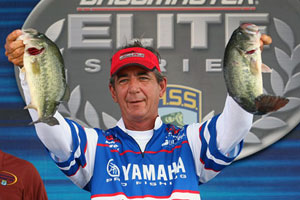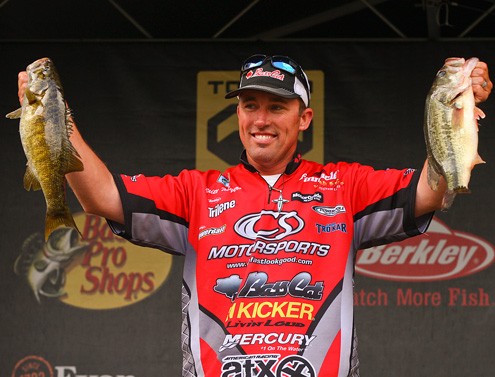At this time of year — at least in the South — bass have one thing on their minds … or do they?
Conventional wisdom would suggest the spawn is their top priority, right? That was certainly the opinion shared among the Elite Series pros in last week’s Bull Shoals event. Essentially every angler in the tournament pursued bass at some stage of the spawn — even the eventual winner, Jason Christie.
But in the end, what distanced Christie from his competitors wasn’t spawning bass at all. It was schooling bass! The Elite Series rookie shocked himself and the entire field by scoring the tournament’s largest one-day stringer by catching schooling bass in a cove near where he had been bank fishing the three previous days.
During his on stage interview, Christie admitted to pursuing the same springtime patterns as his fellow competitors, but added that on the final day he discovered a massive school of largemouth chasing shad in open water.
Recognizing an opportunity, Christie quickly made the adjustment and capitalized. And in doing so he not only set the record for the greatest come-from-behind victory in Elite Series history, he also gained an instant invitation to the 2014 Bassmaster Classic and $100,000 in prize money … all because he seized the moment.

As for the rest of the Top 12, you can bet any of them would love to have had the opportunity presented Christie. But that’s just part of playing the game. Somebody’s going to get the breaks that will help propel them to the top.
What Christie did was remarkable, but not beyond the capabilities of those he competed against. They, too, make adjustments, on a regular basis. KVD is known for it — as are Ike, Chapman, Reese and a bunch of other top performers. These guys enter each event with a basic strategy for locating fish, then modify their search according to varying factors, such as changes in weather, water clarity or temperature, fishing pressure, etc. They try to keep an open mind while piecing things together, knowing full well that change is just around the corner.
In the case of Bull Shoals, everyone expected the fish to be working into some phase of the spawn — either coming in or already fully committed. And throughout much of the lake that played out. But when a major front slammed the region, things changed in a hurry. And that’s when the pros were forced to dig into their bag of tricks.
With Change Comes Opportunity
On the first morning of competition we woke to gusty winds and low, overcast skies. NOAA radar showed a massive line of thunderstorms moving across northwest Arkansas, with a forecast for frequent lightening strikes, hail and the chance of tornadoes. Pushing the front were strong polar winds, which would soon drop temperatures to near freezing. Considering the risks, tournament director Trip Weldon had no choice but to postpone the start of competition.
After a week-long warming trend that had led to stable, reliable patterns, the anglers now faced uncertainty. What would we find once we reached our best areas? And what would we do if things had changed dramatically?

The following day, when the competition finally got underway, we were confronted with a much different lake. Strong winds and heavy rains had stained many of the creeks and pockets, and the water temperature had dropped significantly. For some, the change spelled disaster. For others, it brought opportunity, and they took full advantage.
Ish Monroe and Zell Rowland reported a strong spinnerbait bite — something that was nonexistent during practice. Others, like Kevin VanDam and Britt Myers, cashed in on a healthy crankbait bite — a pattern that dominated last year’s event, but never developed this year until after the front had passed.
As the results will show, those anglers who made the proper adjustments excelled. And in many cases they were forced to adapt daily, sometimes even hourly. Only a handful of the competitors realized success by sticking with a single lure or pattern. But even they were forced to make some adjustments — like changing water, depth or presentation.
Besides having to deal with changing conditions, there were also the various species of bass to consider. On Bull Shoals, both largemouth and smallmouth have the potential for winning — and spotted bass, although more diminutive in size, can help fill out a limit. Exercising the option, many of the competitors made a switch when their original target species failed to cooperate.
Bull Shoals was a true test for the best, and it sent many great anglers home early, scratching their heads, wondering where they went wrong.
If you read my previous column, “Bass are Like People,” you might agree that it was somewhat fortuitous. In that installment, I talked about how certain anglers try to separate themselves from the competition — and how by doing something different or unique, they might increase their odds for success. At Bull Shoals, Jason Christie did something unique, which ultimately separated him from the rest of the field and led him to victory.
So the next time you’re out scouting the lake and everything seems to be falling into place, keep in mind that change is just around the corner … and with it may come opportunity.





